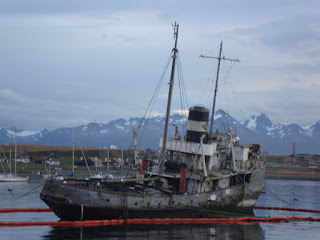
That morning we sat down at our hotel for breakfast and ended up spending some time talking with a really interesting guy named Joaquin. After much discussion of our trip, the earthquakes, the US, and Obama, he told us his tale of being a young man in Chile during its years of dictatorship. At the age of 22, he and a few others were handing out fliers at their university, protesting the government's use of torture, when he was shot and arrested. The officer was aiming for his "kibbles and bits" (and told him so after), but missed and hit his leg. He then spent the next 8 months in prison where he too was tortured. While in prison he organized hunger strikes and all kinds of general disruptions, until they had enough of him and exiled him to France for 8 years. It wasn't until the early 80's that Chile began to reconcile their senseless killing and torturing of many of their citizens. Eventually, Joaquin was issued a official apology from the government and was granted a very small pension for his enduring of these tragedies. Even though he was allowed to return to Chile sometime in the late 80's, he couldn't bring himself to do so until about 6 years ago. Joaquin's experience is one that would leave most people bitter and twisted beyond recognition. Yet, this man was one of the kindest people I have met and had uniquely positive outlook on life. When on the road, you meet all kinds of people who leave a lasting impression on you. Joaquin's good nature and positivity were almost infectious and he was by far the most interesting individual I have met on this trip.
Photo of Mikey and Joaquin...all smiles.
 We were back on the road the next morning and ready to get off the island, soon to overcome the same obstacles we encountered on the way in. Accompanied by the heavy winds, cold temperatures and a blanket of rain, we rode out of Argentina, into Chile, crossed the Straight of Magellan, and back into Argentina. We took the opportunity to warm up inside the ferry during the 20 minute ride across the straight. The trip began to take on a different feel, it was now a matter of the machines holding up for the final stretch. Everything on the bike had been put through the gauntlet. The rear sprocket teeth were so thin and hooked they looked like cheap, bent steak knifes. The tires were down past the wear marks, the brakes were beginning to fade, air filters clogged with soot, dust, and sand, and the spark plugs were crusted black with carbon. But like the troopers that the KTMs were, they kept us on the move.
We were back on the road the next morning and ready to get off the island, soon to overcome the same obstacles we encountered on the way in. Accompanied by the heavy winds, cold temperatures and a blanket of rain, we rode out of Argentina, into Chile, crossed the Straight of Magellan, and back into Argentina. We took the opportunity to warm up inside the ferry during the 20 minute ride across the straight. The trip began to take on a different feel, it was now a matter of the machines holding up for the final stretch. Everything on the bike had been put through the gauntlet. The rear sprocket teeth were so thin and hooked they looked like cheap, bent steak knifes. The tires were down past the wear marks, the brakes were beginning to fade, air filters clogged with soot, dust, and sand, and the spark plugs were crusted black with carbon. But like the troopers that the KTMs were, they kept us on the move.















































